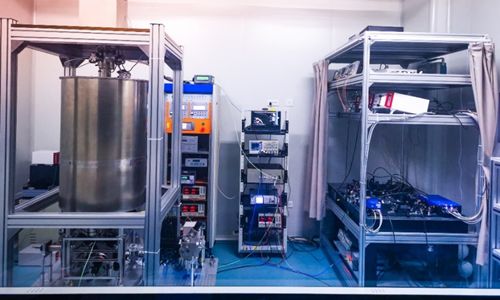Recently, the Circular T 435 bulletin of the Bureau International des Poids et Mesures (BIPM) published the 18 consecutive months frequency data of the cesium atomic fountain clock (No. NTSC-CsF2), marking that the cesium atomic fountain clock independently developed by the National Time Service Center(NTSC) of the Chinese Academy of Sciences(CAS) is recognized to participate in the calibration of the international reference time scale (Coordinated Universal Time (UTC)), and starts to steer the International Atomic Time (TAI).
TAI is an integrated time scale based on the second of the International System of Units (SI). Leap seconds are added as needed to TAI to generate UTC. The SI unit of time ‘second’ is defined as the constant of the unperturbed ground-state hyperfine transition frequency of the caesium-133 atom, which is a fixed value of 9192631770 Hz. At present, cesium atomic fountain clock is the primary frequency standard (PFS) realizing the definition of second.
BIPM applies more than 600 time-keeping atomic clocks operated in 88 time-keeping laboratories represent different countries and regions to generate continuous and stable Echelle Atomique Libre (EAL) through international frequency comparison and computation every day. And then, after regular calibration by about 10 cesium atomic fountain clocks located in different countries, EAL becomes a continuous, stable and accurate TAI computed values (paper time scales), which are routinely published in the form of a bulletin (Circular T) with a time delay of 7 days (initial computation) or 1 month (actuarial computation) for calibrating the national or regional time scale kept by their respective time-keeping laboratories.
According to the bulletin, the frequency uncertainty of the cesium atomic fountain clock, which is currently serving as the PFS for the TAI calibration, is in the range of 1.1×10-16 to 1.4×10-15 .
A research team led by Prof. ZHANG Shougang from NTSC has been focusing on the development of reliable and high-performance cesium atomic fountain clocks for nearly 20 years. The researchers studied 13 physical and technical issues affecting the frequency uncertainty of fountain clocks, achieving a cesium atomic fountain clock device NTSC-CsF2 with a frequency stability of 2.1×10-13 τ-1/2 (high atomic density) and a frequency uncertainty of 4.3×10-16.
Through the Global Navigation Satellite System (GNSS) frequency comparison link, the research group conducted the frequency comparison measurements between NTSC-CsF2 and the other reference clocks calibrating TAI for eight months from August 2022 to March 2023 to verify the performance of the cesium atomic fountain clock NTSC-CsF2. The results showed that the frequency uncertainty of 4.3×10-16 independently evaluated by the research group is scientific and reasonable. The results are published in Metrologia.
In December 2023, relevant researchers from the Timekeeping Laboratory and the Quantum Frequency Standards Laboratory of NTSC submitted a written application to the Consultative Committee for Time and Frequency Working Group on Primary and Secondary Frequency Standards (CCTF WG PSFS) under BIPM to contribute to the steering of TAI. This working group conducted several rounds of discussions and evaluations on the operational status, performance indicators, and comparison results of the cesium atomic fountain clock NTSC-CsF2. In March 2024, all members of the working group unanimously agreed to allow NTSC-CsF2 to contribute to the steering of TAI.
NTSC has applied domestically produced hydrogen masers, as well as self-developed optically pumped cesium beam standards, rubidium atomic fountain clocks, cesium atomic fountain clocks, and universal time measurement systems to independently generate the national reference time scale UTC(NTSC), also known as Beijing Time. The application of the cesium atomic fountain clock NTSC-CsF2 as a PFS in the national time-keeping system ensures that the national reference time scale does not need to use delayed international comparison data any more, and can still ensure the accuracy of the national reference time scale without international frequency comparison in special circumstances.

NTSC-CsF2(Image by NTSC)
CONTACT:
XIONG Tiantian
National Time Service Center, Chinese Academy of Sciences
gjhz@ntsc.ac.cn
 Print
Print